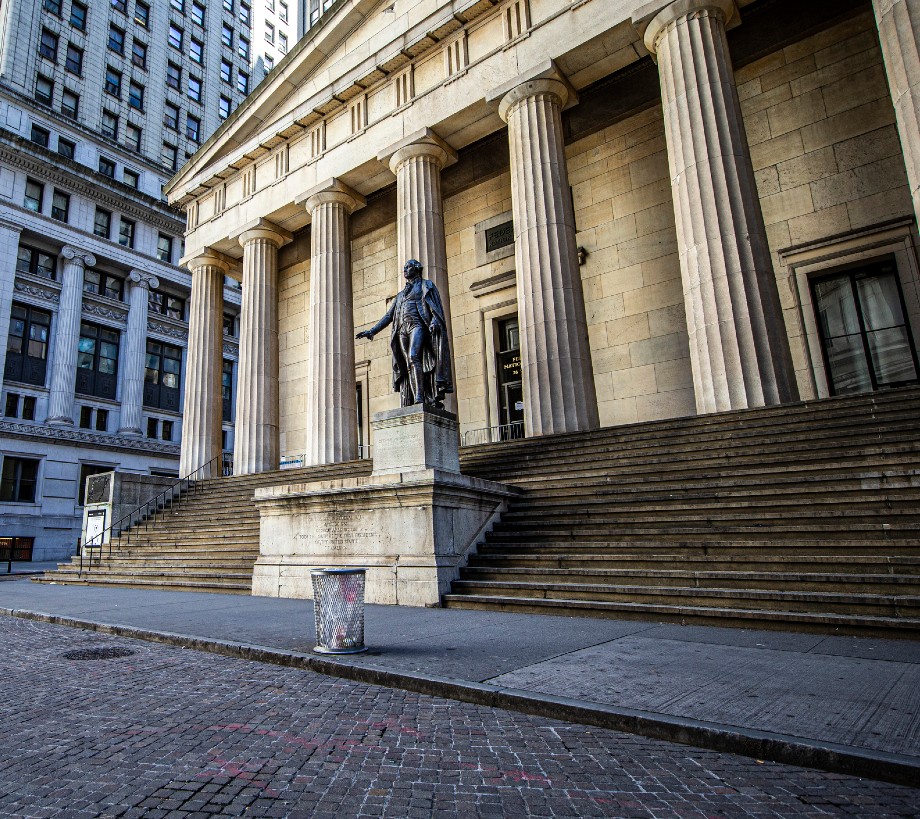Historical Highlights

From City Hall to The Battery, this tour affords a unique window onto Lower Manhattan and offers visitors an overview of some of the most significant historical sites in all of New York City.
For more than a century, there was no New York City north of Chambers Street. Lower Manhattan was New York City. Now, with more than 400 years of living history amidst an ever-expanding metropolis, this singular, dynamic neighborhood remains a bridge to our country’s past and a gateway to its future. It is where George Washington took the first Presidential oath and where millions of immigrants first entered America. It is the site of one of our nation’s gravest tragedies, and it is also a symbol of American’s resilience. It is now a center for government and finance, the capitol of world commerce, home to tech start-ups and media giants alike and is the location of a dramatic evolution in urban geography and identity. The story of Lower Manhattan is epic — a story of determination and innovation and sacrifice — a story every American should know.
From City Hall to The Battery, this tour affords a unique window onto Lower Manhattan and offers visitors an overview of some of the most significant historical sites in all of New York City.
Start your trip at City Hall, the oldest city hall in America to serve its original purpose as the place where the Mayor and City Council conduct the city’s business. Built between 1803 and 1812, the building is situated on what was once the northernmost edge of New York City. Note the beautiful white marble façade on the front of the building and compare it to the brownstone used for the back— an indication that no one expected city to ever expand beyond Lower Manhattan! And as old as City Hall may be, the adjacent park is much older, dating back all the way to Colonial Dutch days.
Continue on to one of Manhattan’s most storied attractions — no visit to the city is complete without a trip to see the Brooklyn Bridge. Completed in 1883, the bridge joined New York with Brooklyn (which had been two separate cities). Designed by German immigrant John Augustus Roebling, it was the world’s longest suspension bridge and its enormous support towers were once New York’s tallest structures. A week after the official opening of the bridge, rumors swirled that the structure was collapsing. Amidst the panic, a stampede ensured and a dozen people were killed. Obviously the rumor proved to be false — public fears were finally put to rest when the great circus showman, P.T. Barnum, paraded 21 elephants across the span.
Another meticulously designed piece of NYC history stands nearby. The Woolworth Building is an impressive architectural wonder. Dubbed the “Cathedral of Commerce,” the 60-story masterpiece was once the world’s tallest building. The breathtaking lobby contains jewel-like mosaics, filigree brass work and, hidden among the gnarled gargoyles tucked into the corners, figures of Cass Gilbert and the building’s namesake Frank Woolworth. Woolworth, of “five-and-dime” store fame, paid $13.5 million in cash to have the building built; it served as the headquarters of the renowned Woolworth department stores. Sadly, the lobby is no longer open to the public, but seeing the sheer majesty of the building is worth trying to peak through the front doors.
Further down along Broadway, St. Paul’s Chapel stands as the oldest public building in continuous use in New York City. Built in 1766 as the “uptown” extension of Trinity Church a few blocks south, 18th century regulars included George Washington, who walked to the chapel from Federal Hall to attend the Thanksgiving service following his first inauguration. His carefully preserved pew is still on view. The small chapel may also be considered the “mighty chapel that could”— St. Paul’s has survived fires, blizzards and the World Trade Center terror attacks on September 11, 2001. The chapel served as a place for rest and refuge to those working in the rescue efforts following the attacks. St. Paul’s has now become a museum and shrine to the history of post-9/11 recovery efforts in Lower Manhattan and memorials from around the world.
Throughout its history Lower Manhattan has been known as the world’s financial center. Just down Broadway and to the left on Liberty Street sits the New York branch of the Federal Reserve Bank — one of the most important and powerful institutions in Lower Manhattan. What’s inside the building is worthy of the bank’s imposing design, modeled after an Italian Renaissance palace. More than one quarter of the world’s monetary gold supply is securely stored five stories underground in a vault closed with a mammoth steel door weighing 90 tons.
While the Federal Reserve Bank may be one of Lower Manhattan’s most powerful institutions, Trinity Church is one of the most iconic and one of the oldest buildings in New York City. The church was founded in 1697 by royal charter. The current neo-Gothic building — the third Trinity Church to be erected at the sight — was built in 1846. It was the tallest structure in New York until the Brooklyn Bridge towers were built 30 years later. The church itself is not the property’s only attraction. Though slightly more macabre, the church cemetery is the final home of the “who’s who” of New York history. Alexander Hamilton, Robert Fulton and members of the Astor family are buried here, along with members of the British royal court and publishing magnates.
A few blocks north of Trinity Church is the World Trade Center site. The complex includes the 9/11 Memorial & Museum and Reflection Pools. Set amongst a grove of trees, the pools sit in the footprints of the Twin Towers and bear the names of the nearly 3,000 people who died that day. The pools are now free and open to the public, but time and date specific reservations are required to visit the museum.
When the Dutch settled here in 1626, Wall Street marked the city’s northern limit. Today, Wall Street stands as the symbol of American capital and strength. Originally, “de Waal Straat” served as a physical defense, the wall built to protect New York City. Unfortunately, the wall offered zero protection from sea-bound vessels. And when the British navy arrived, Stuyvesant quickly surrendered to British rule. From the time Alexander Hamilton founded the Bank of New York in 1784, Wall Street has been the symbol and center of global commerce and trade.
Aptly so, the New York Stock Exchange sits on the corner of Wall and Broad. The NYSE traces its history to the signing of the “Buttonwood Agreement” back in 1792. The agreement set the basic rules for trading that are still in use today. Within the walls of the Exchange, billions of dollars’ worth of stock are traded every day. From 24 founding members, the Exchange has grown to over 2,300 member companies. The historic merger of the New York Stock Exchange and Euronext in 2007 created NYSE Euronext — the world’s largest global marketplace — representing trillions of dollars in annual trading.
The Federal Hall National Monument sits just across the way from the NYSE. The monument is the site of New York’s second city hall and of George Washington’s inauguration as America’s first President. In addition to the original G.W., the post-revolutionary Congress met at Federal Hall as well and adopted the Bill of Rights, or the first ten amendments to the Constitution.
Fraunces Tavern was another one of George Washington’s favorite haunts in Lower Manhattan. Originally built as a private residence in 1719, the building was sold in 1762 to Samuel Fraunces who promptly became famous for his skill in the kitchen. New Yorkers didn’t just go to the tavern for a good meal; they went also for political discussions. On December 4, 1783, General George Washington retired from military service in the tavern’s Long Room. Fraunces Tavern continued to serve as the offices of Foreign Affairs, the Treasury and the War Department until 1790. Today, it remains one of New York’s oldest surviving buildings as well as a museum and restaurant.
Lower Manhattan history is not only confined to indoor spaces. The history of Bowling Green Park goes back to the 1630’s, when the Dutch declared it the site of an annual cattle and grain market. In 1733, three colonists leased it from the English crown for the nominal fee of one peppercorn a year, and it became New York’s first park. The British installed a statue of King George III in 1770 and built the fence to protect the statue soon after. The statue was torn down on July 9, 1776 by an angry mob following George Washington’s order of the Declaration of Independence. The fence remains intact, and now the park is home to yet another famous sculptural resident. Arturo di Modica’s famed Charging Bull sits at the northern trip of Bowling Green Park. The bull mysteriously appeared one night in front of the New York Stock Exchange. Having been moved to its current location, it has become the symbol of Wall Street’s optimism and a must-see NYC attraction.
Just down from the Charging Bull in Bowling Green is the Alexander Hamilton U.S. Custom House. Designed by Cass Gilbert, the Beaux Arts building was built between 1902-1907 and is flanked by four large sculptures designed by artist Daniel Chester French. The building was originally built to house the import duty operations from the port of New York. As the nation’s busiest port, New York collected more than two-thirds of all customs revenue, essentially financing the federal government. The size and ornamentation of the building reflect the importance of the business conducted within, and the increased power of the United States on the world stage. After the Customs office moved out of this location in 1973, the building stood vacant and was nearly destroyed. After extensive restoration and design work, today the building is home to the Smithsonian’s National Museum of the American Indian and Federal Bankruptcy Court.
History is everywhere in Lower Manhattan, even in the places that are not always the most obvious. Named for the battery of canyons that protected the harbor, The Battery contains numerous memorials, the ferries to Ellis Island and the Statue of Liberty as well as Castle Clinton. Originally known as Capske Hook, the Battery ran an irregular line between what is now Battery Place and New York Harbor, the shoreline extended in the 18th and 19th centuries. In 1826, Castle Clinton became the “Castle Garden” and served as everything from a promenade, restaurant and theater to operating as New York’s immigration center from 1855-1992. Throughout the park, one can also find several memorial monuments. A flagpole donated by the Netherlands in 1926 depicts the 300th anniversary of the Dutch arrival to Manhattan, Hope Garden is a memorial to the AIDS pandemic, the East Coast Memorial commemorates the brave American servicemen who perished in the Atlantic Ocean during World War II and the Museum of Jewish Heritage which is a repository of Jewish culture and a place of remembrance for the victims of the Holocaust.
Located just a few blocks away from Battery Park and the modern high rise buildings of Wall Street, Stone Street remains a cobblestone testament to New York’s Dutch past. It is also a favorite gathering place for many of Lower Manhattan’s young worker community. Along with drinks, the street offers plenty of places to eat. Whether you’re up for just drinks or some food too, grab a seat and settle in for a true New York night.
Tags: History, must see downtown

